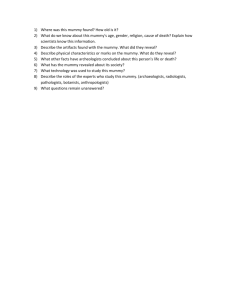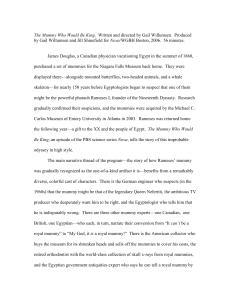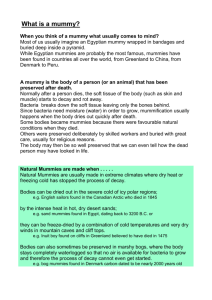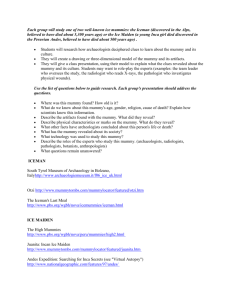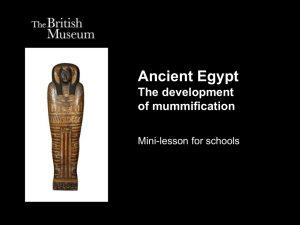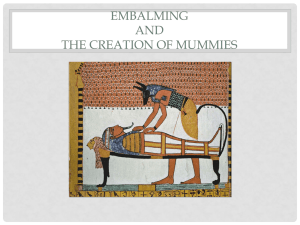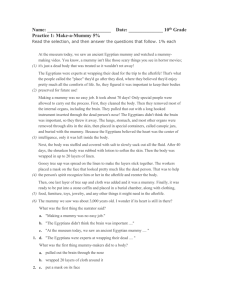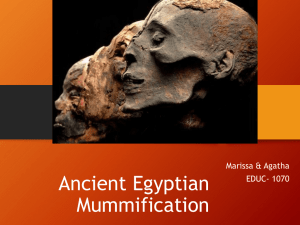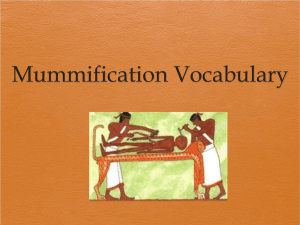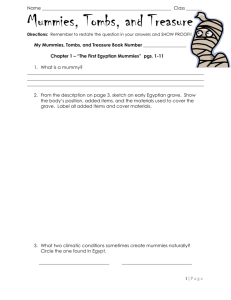File
advertisement
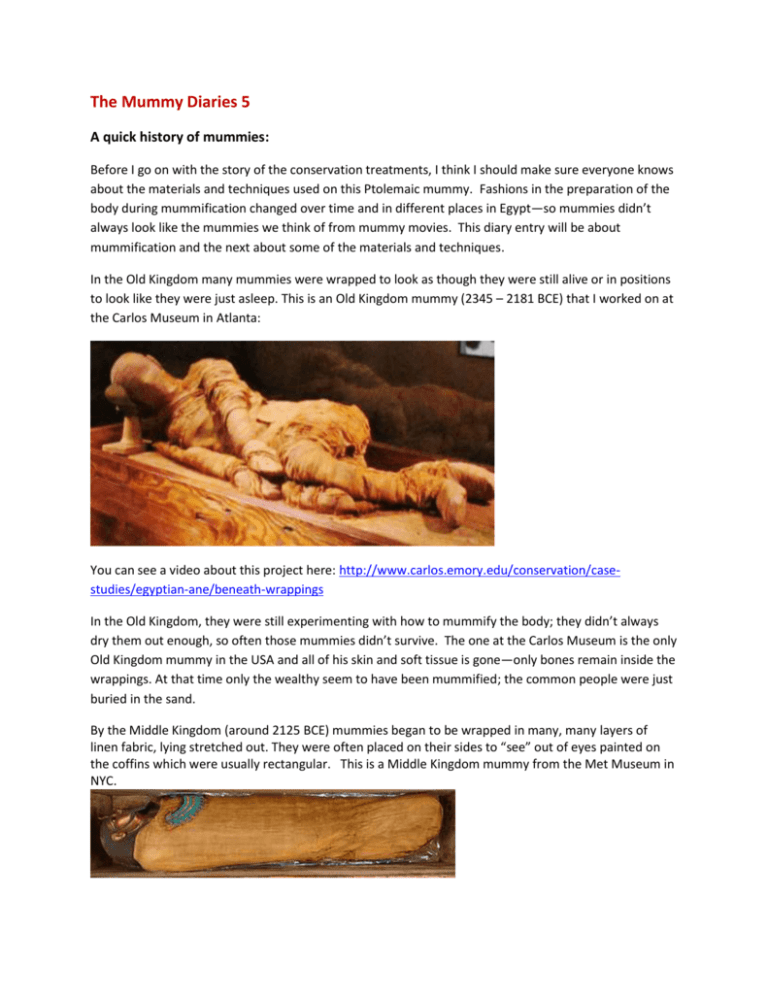
The Mummy Diaries 5 A quick history of mummies: Before I go on with the story of the conservation treatments, I think I should make sure everyone knows about the materials and techniques used on this Ptolemaic mummy. Fashions in the preparation of the body during mummification changed over time and in different places in Egypt—so mummies didn’t always look like the mummies we think of from mummy movies. This diary entry will be about mummification and the next about some of the materials and techniques. In the Old Kingdom many mummies were wrapped to look as though they were still alive or in positions to look like they were just asleep. This is an Old Kingdom mummy (2345 – 2181 BCE) that I worked on at the Carlos Museum in Atlanta: You can see a video about this project here: http://www.carlos.emory.edu/conservation/casestudies/egyptian-ane/beneath-wrappings In the Old Kingdom, they were still experimenting with how to mummify the body; they didn’t always dry them out enough, so often those mummies didn’t survive. The one at the Carlos Museum is the only Old Kingdom mummy in the USA and all of his skin and soft tissue is gone—only bones remain inside the wrappings. At that time only the wealthy seem to have been mummified; the common people were just buried in the sand. By the Middle Kingdom (around 2125 BCE) mummies began to be wrapped in many, many layers of linen fabric, lying stretched out. They were often placed on their sides to “see” out of eyes painted on the coffins which were usually rectangular. This is a Middle Kingdom mummy from the Met Museum in NYC. In the New Kingdom, we have examples of royal burials like Tutankhamun, where the body was really well preserved in the mummification process, laid out with the arms crossed and placed in multiple coffins shaped like the mummy. Here is the mummy of Rameses II—you can see how well preserved he is: During the New Kingdom, more and more common people were getting mummified for burial and in the dynasties that followed it became customary for everyone except the very poorest to be mummified. Their burials imitated royal fashions of the time but with less expensive materials. So if a royal coffin was made from gold inlaid with gems, a common one would be made from wood or sometimes from cartonnage (a material like paper mache that I will talk about in another diary entry) and decorated with paint. This is the painted cartonnage inner coffin of Tabes, a temple singer from the 22nd Dynasty (945 – 818 BCE) that I worked on at the MFA in Boston. She once had other coffins to cover this one but they did not survive. Just a little later, from somewhere in the 23 – 25th dynasties (760 – 660 BCE), is the mummy and coffin set of Nesmutaatneru that I also worked on at the MFA. By this time, the body was well mummified, wrapped lying out with the arms down instead of crossed. It was the fashion to have beautiful net coverings of faience beads over crossed bandages on the outer shroud covering of the mummy (her shroud was dyed pink). Nesmutaatneru’s bead net also has a winged heart scarab and the four sons of Horus. Her mummy was placed into this group of coffins, ending with the large, rectangular outer sarcophagus. I suspect that this was an expensive burial! You can visit these mummies at the MFA. By the Late Period and going into the Ptolemaic Period (663 – 30 BCE), the fashion for just cartonnage masks instead of entire cartonnage coffins came back – it was probably less expensive! Other panels and plaques of cartonnage were added, too. And that is how Minirdis’s mummy was decorated. Here is another mummy that I completed from the Academy of Natural Sciences in Philadelphia that has similar cartonnage panels (she came from the same town as Minirdis but we don’t know her name so we call her Annie for anonymous): During the Roman Period mummification changed a lot. The process of mummification became more sloppy and poorly done so the bodies often did not survive well. Mummies frequently did not have coffins or they only had plain wooden boxes, shaped a lot like our coffins today. Many mummies had painted wooden panels with portraits of the deceased on them that look more like modern portraits than the stylized ancient Egyptian masks. The bodies were often wrapped with elaborate interlacings of linen bands. Here is a mummy of a Roman child that I worked on at the MFA: The linen is still covered with the dirt from the burial. After Christianity came to Egypt, mummification was banned by the church and there were no more mummies or such elaborate burials.
